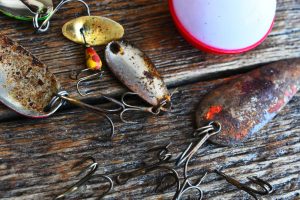Fishing lures are a significant investment, and nothing is more frustrating than discovering rust on your prized collection. Rust not only diminishes the aesthetic appeal of your lures but also affects their performance and lifespan. Luckily, with the right techniques and tools, you can restore your lures to their former glory. Here’s a comprehensive guide on how to get rust off your lures and keep them in top shape for your next fishing trip.
Why Do Lures Rust?
Before diving into the removal process, it’s essential to understand why lures rust in the first place. Rust occurs when iron or steel in your lures reacts with oxygen and moisture, leading to corrosion. This can happen if lures are stored improperly or not dried adequately after use, especially in saltwater environments where corrosion happens faster due to the salt.
Tools and Materials You’ll Need
- Vinegar or Lemon Juice: These acidic solutions help dissolve rust.
- Baking Soda: Works as a mild abrasive and neutralizer for acids.
- Steel Wool or Scrub Pad: For scrubbing off the rust.
- Toothbrush: For getting into hard-to-reach areas.
- Protective Gloves: To protect your hands from sharp hooks and cleaning agents.
- WD-40 or Rust Remover: To treat stubborn rust spots.
- Clean Cloth: For drying and applying protective coatings.

Step-by-Step Rust Removal Process
1. Soak the Lures:
Begin by soaking the rusted lures in white vinegar or lemon juice for about 1-2 hours. The acidic properties of these liquids will help break down the rust, making it easier to remove. For lighter rust, soaking for just 30 minutes may be sufficient.
2. Scrub the Rust Away:
After soaking, use steel wool, a scrub pad, or an old toothbrush to gently scrub the rusted areas. Be thorough but cautious to avoid scratching or damaging the lure’s surface. Focus on the hooks, rings, and other metal components, as these are the most susceptible to rust.
3. Use Baking Soda Paste:
For stubborn rust spots, make a paste using baking soda and water. Apply it to the rusted areas and scrub again with your chosen tool. Baking soda acts as a mild abrasive that helps remove tough rust without damaging the lure.
4. Rinse and Dry:
Once the rust is removed, rinse the lures with clean water to remove any residue from the cleaning agents. Dry them thoroughly with a clean cloth. Ensure there’s no moisture left on the lures before storing them to prevent further rusting.
5. Apply a Protective Coating:
To prevent rust from returning, apply a light coat of WD-40, a rust preventative, or a small amount of oil to the metal parts of the lure. This creates a protective barrier against moisture. Be sure to wipe off any excess oil to avoid making the lure too slippery to handle.
Tips for Preventing Future Rust
- Dry Thoroughly After Use: After each fishing trip, especially in saltwater, rinse your lures in fresh water and dry them thoroughly before storing them.
- Proper Storage: Store lures in a dry, cool place. Consider using a tackle box with a built-in moisture absorber or adding silica gel packets to absorb excess moisture.
- Regular Maintenance: Inspect your lures regularly for signs of rust and clean them as needed. Regular maintenance can prevent minor rust spots from becoming significant problems.
Rusty lures don’t have to be a lost cause. With a little effort and the right approach, you can remove rust and extend the life of your fishing gear. By incorporating rust prevention into your regular fishing routine, you’ll keep your lures in top condition, ensuring they’re always ready for your next catch.
Image: Zerust





